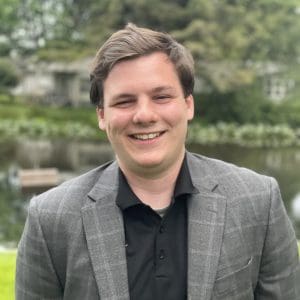Biography:
Brendon studies DNA replication and epigenetics in Drosophila (fruit fly) male germline stem cells. These are the stem cells in adult flies that eventually give rise to sperm. The first step in this process is stem cell division, where the stem cell divides to produce a self-renewed stem cell and a differentiating cell (the cell that will become sperm). Brendon is interested in how one cell division occurs asymmetrically to lead to two distinct cell fates, an important aspect of multicellular development, maintenance, and aging. When stem cells divide symmetrically, the result can be overproliferation of the stem cells, resulting in a tumor, or loss of stem cells entirely, a hallmark of aging and age-related diseases. Improving the “decision-making” involved in stem cell division would be an important step towards new therapeutic approaches to these problems.
An improbable puzzle:
Brendon joined Dr. Xin Chen’s lab. The lab previously found that Drosophila male germline stem cells divide asymmetrically with respect to old and new histones. Histones are the packaging proteins that DNA is wrapped around, and they are modified in ways that change DNA accessibility and gene expression. Because of this compaction, histones are considered an incredibly important element of the “epigenome.” When a germline stem cell divides, older histones—those that were already incorporated before the last round of DNA replication—are retained by the stem cell while newly incorporated histones get sent to the differentiating daughter cell. This makes for an elegant system to define two different cell fates, because the two daughter cells are inheriting two distinct epigenetic landscapes that could change how their genes are expressed. To separate histones so neatly, the cell has to sort them into two groups, something easier said than done. At the core of the problem, a stem cell would need a mechanism to incorporate old histones into one copy of its DNA and new histones into the other copy. This “sorting mechanism” is the focus of Brendon’s research. The Chen Lab found that sorting happens during DNA replication (S phase). As the cell is copying its DNA, it is also sorting histones onto opposite copies. Brendon narrowed in on this, looking at the level of individual replication forks that are actively copying DNA. As one DNA strand becomes two, old and new histones associate with opposite strands. Essentially, the cell is building asymmetric strands of DNA the moment they are copied. Brendon found that this process occurs because one of the two strands—the lagging strand—replicates more slowly in these cells resulting in old histones on the parent strand being automatically recycled to the fast-replicating leading strand. The only space left for new histones to go is the lagging strand. And voilà, local asymmetry! Multiple other steps are required to get to the global histone asymmetry that is observed when the germline stem cells divide. Brendon is continuing to investigate these mechanisms. He is also trying to understand where in the genome this asymmetry really matters. Because the male germline stem cells are going to so much trouble to create a new epigenome for the differentiating cell, it follows that certain genes or gene regions would be particularly dependent on this in order to change expression as the cells differentiate.
Oh no, not politics:
Brendon is a big supporter of finding regular activities outside of the lab to prevent burnout and develop other areas of interest. He is the Vice President for Science Policy in the Johns Hopkins Science Policy and Diplomacy Group. With this group, Brendon has led trips to Washington, DC to meet with members of Congress about science policy issues and advocate for evidence-based policies. Beyond academic pursuits, Brendon also lifts regularly and has competed in three powerlifting meets since moving to Baltimore.
A traitor to worms:
Brendon grew up in Spokane, WA, and knew he wanted to go into science since middle school. He went to the University of Washington for undergraduate studies, where he got degrees in biology and math. While there, Brendon studied in the lab of Dr. Matt Kaberlein, working with the nematode C. elegans to study the mechanisms of aging. Brendon also got his first exposure to fruit flies in a hands-on lab class where students were given freedom to design and test their own experimental questions. After graduation, Brendon took a year to work in Dr. Alexander Mendenhall’s lab at UW, studying the interaction between models of cancer and Alzheimer’s Disease in C. elegans. After enrolling in the JHU CMDB program, Brendon fondly remembers driving a U-Haul across the entire country to Maryland.
